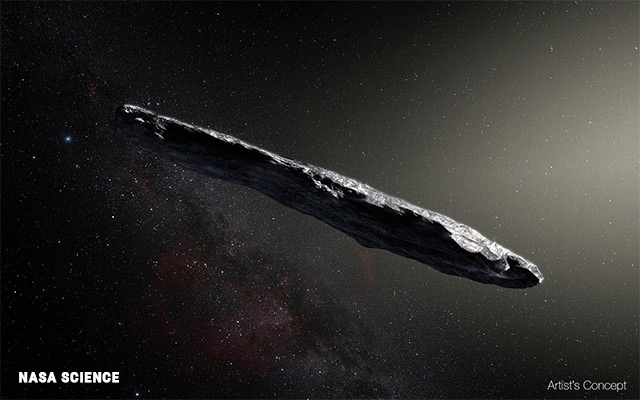
Scientists have recently confirmed that ‘Oumuamua (pronounced oh MOO-uh MOO-uh), the first known interstellar object to visit our solar system, is a comet after all. Discovered on October 19, 2017 by the University of Hawaii’s Pan-STARRS1 telescope, ‘Oumuamua baffled astronomers. Its strange, cigar-like shape, along with the absence of usual cometary activity had scientists wondering if it really was a comet or something else. It was briefly classified as an asteroid, then as a new “interstellar objects” class, until new measurements provided enough evidence as to its true classification.
A new paper published in Nature found that despite ‘Oumuamau’s unusual shape and speed, the object travels along an arc that “can’t be entirely explained by the gravitational pull of the sun, planets, and other solar system objects,” according to Space.com. This led scientists to hypothesize that ‘Oumuamua’s acceleration was not caused by gravity.
While other factors may explain this type of non-gravitational acceleration, like solar radiation pressure, and forces of drag and friction, researchers believe that ‘Oumuamua is being propelled by gas, which would make it a comet. Further, astronomers found that ‘Oumuamua was accelerating slightly, another sign that it was behaving more like a comet.
All the same, ‘Oumuamua is not a typical comet. It does not carry a coma, which is the cloud of gas and dust that surrounds a comet’s core. ‘Oumuamua likewise lacks the classic comet “tail.”
Karen Meech, an astronomer at the University of Hawaii and one of the authors of the new study has said that their research “conclusively ends” the mystery of what ‘Oumuamua is but that “there’s never a hundred percent guarantee on anything.”
‘Oumuamua is Hawaiian for “a messenger from afar arriving first.” Its technical name is 1I/2017, given by the International Astronomical Union (IAU).
Why ‘Oumuamua is important
‘Oumuamua is the first confirmed interstellar object to pass through our solar system. When it was first detected, it was traveling at speeds of 196,000 miles per hour (or 54 miles or 87.3 kilometers per second). Space objects from within our solar system typically travel at much slower speeds (around 12 miles or 19 km per second).
Scientists suggest that ‘Oumuamua came from the rough direction of the constellation Lyra, but it’s impossible to tell where exactly it originally came from. It could have started to wander from its parent planetary system thousands of years ago -- but it is also possible that it could have been wandering the galaxy for billions of years.
What is so unusual about ‘Oumuamua is that astronomers really have no idea what it looks like. ‘Oumuamua appears as a speck of light in even the most advanced telescopes. Its unique rotation, however, has made scientists think it looks roughly like a cigar, about 10 times longer than it is wide.
‘Oumuamua appears to be heading out of our solar system and won’t be coming back. Scientists have confirmed that it is rapidly heading towards the constellation Pegasus and will cross the orbit of Neptune by 2022 and cover one light year’s distance in about 11,000 years.
Don’t worry though -- astronomers say that ‘Oumuamua may have heralded a new age when more interstellar objects will enter our solar system. (Related: NASA updates its plan to deflect potentially hazardous Earth-bound asteroids.)
For more fascinating space stories, head over to Cosmic.news today.
Sources include:
Please contact us for more information.













